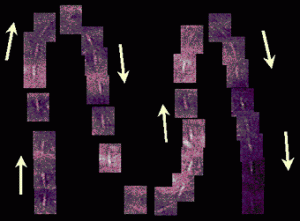Using Micro-organisms for Controlling Contaminants
Removing contaminants from raw materials or from industrial waste water by using micro-organisms is a very attractive approach to achieve more sustainable ‘cleaning’ processes in industry. Such an approach permits energy savings to be achieved and helps to avoid potentially hazardous chemicals.
The Energy and Climate Change Division has been involved in research utilising bacteria for industrial contaminant control. The work has concentrated on bacteria with magnetic properties which, for example, can be used to immobilize heavy metals from a surrounding solution. These magnetic properties permit removal of bacteria and contaminants from the solution by using a superconducting, permanent or electromagnet.
Certain bacteria naturally possess magnetic properties by containing magnetite crystals which in nature enables them to navigate according to the earth’s magnetic field. The group has conducted research on optimising the growth conditions of bacteria cultures and the process conditions for magnetic separation.
Various studies have been conducted for developing techniques that would allow magnetotactic bacteria (MTB) to be used in the clean-up of hazardous metals. The magnetic properties of the bacteria enable their application for wastewater treatment, i.e. the clean-up of hazardous metals such as those encountered in the nuclear and heavy metal producing industries.
Under a microscope the chain of magnetite crystals (magnetosomes) is clearly visible inside a bacterium (Figures 1 & 2), imparting the bacterium with a magnetic dipole moment along it’s length. Each magnetosome crystal is 40-60 nm in length.
The chain of magnetite crystals acts as a ‘compass’ aligning the bacteria with the external magnetic field. In nature, this enables the bacteria to navigate with respect to the earth’s magnetic field, towards their ideal environment in the upper, micro-aerobic sediments of ponds and streams.
In the northern hemisphere, the majority of magnetotactic bacteria are ‘north seeking’, i.e. swim towards south pole of a bar magnet. This is shown in Figure 3. In the southern hemisphere, the converse is true with ‘south seeking’ bacteria dominating. At the geomagnetic equator, equal populations of north and south seeking bacteria exist.
The u-turn motion of magnetotactic bacteria in switching, linear magnetic fields has been studied enabling the magnetic moment to be calculated. The magnetic dipole within a magnetotactic bacterium, rotates through 180 degrees when the polarity of the applied magnetic field is reversed. From the time and diameter of the u-turns the magnetic moment may be estimated. Figure 4 shows a sequence of video frames capturing the motion of a swimming bacterium during a 3 u-turn, 2 second track. A typical turn diameter is 60 microns, with a bacterium swimming at approximately 40 µm/s, under an applied field of 7 gauss (0.7 mT).
From these results it has been possible to develop an understanding of magnetic moment development within a culture with growth. If, in a chamber for example, magnetotactic bacteria immobilise heavy metals from a surrounding solution, they can then easily be separated by applying a low intensity, focussing magnetic field. This principle has been extended to develop a treatment process for the removal of metals from wastewater.
Aspects of this work have been published in:
Bahaj A.S., James P.A.B. and Moeschler F.D. (2002) Efficiency enhancements through the use of magnetic field gradient in orientation magnetic separation for the removal of pollutants by magnetotactic bacteria. Separation Science and Technology, Volume 37, Number 16, pp 3661-3671. View paper
Bahaj A.S., Croudace I.W., James P.A.B., Moeschler F.D. and Warwick P.E. (1998) Continuous radionuclide recovery from wastewater using magnetotactic bacteria. Journal of Magnetism and Magnetic Materials, Vol. 184, Issue 2, April 1998, pp 241-244. View paper




